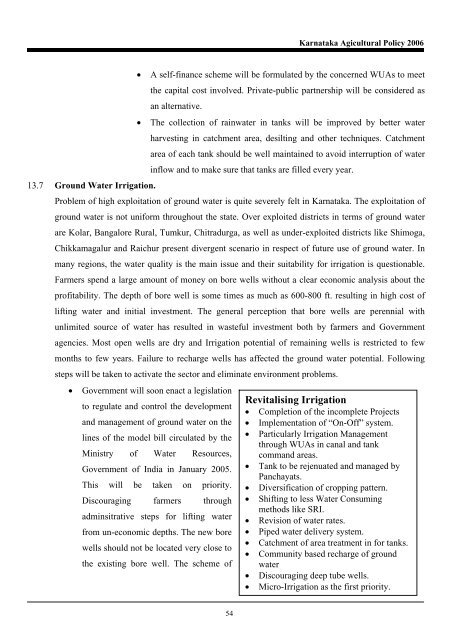Karnataka Agricultural Policy - Institute for Social and Economic ...
Karnataka Agricultural Policy - Institute for Social and Economic ...
Karnataka Agricultural Policy - Institute for Social and Economic ...
Create successful ePaper yourself
Turn your PDF publications into a flip-book with our unique Google optimized e-Paper software.
<strong>Karnataka</strong> Agicultural <strong>Policy</strong> 2006<br />
• A self-finance scheme will be <strong>for</strong>mulated by the concerned WUAs to meet<br />
the capital cost involved. Private-public partnership will be considered as<br />
an alternative.<br />
• The collection of rainwater in tanks will be improved by better water<br />
harvesting in catchment area, desilting <strong>and</strong> other techniques. Catchment<br />
area of each tank should be well maintained to avoid interruption of water<br />
inflow <strong>and</strong> to make sure that tanks are filled every year.<br />
13.7 Ground Water Irrigation.<br />
Problem of high exploitation of ground water is quite severely felt in <strong>Karnataka</strong>. The exploitation of<br />
ground water is not uni<strong>for</strong>m throughout the state. Over exploited districts in terms of ground water<br />
are Kolar, Bangalore Rural, Tumkur, Chitradurga, as well as under-exploited districts like Shimoga,<br />
Chikkamagalur <strong>and</strong> Raichur present divergent scenario in respect of future use of ground water. In<br />
many regions, the water quality is the main issue <strong>and</strong> their suitability <strong>for</strong> irrigation is questionable.<br />
Farmers spend a large amount of money on bore wells without a clear economic analysis about the<br />
profitability. The depth of bore well is some times as much as 600-800 ft. resulting in high cost of<br />
lifting water <strong>and</strong> initial investment. The general perception that bore wells are perennial with<br />
unlimited source of water has resulted in wasteful investment both by farmers <strong>and</strong> Government<br />
agencies. Most open wells are dry <strong>and</strong> Irrigation potential of remaining wells is restricted to few<br />
months to few years. Failure to recharge wells has affected the ground water potential. Following<br />
steps will be taken to activate the sector <strong>and</strong> eliminate environment problems.<br />
• Government will soon enact a legislation<br />
to regulate <strong>and</strong> control the development<br />
<strong>and</strong> management of ground water on the<br />
lines of the model bill circulated by the<br />
Ministry of Water Resources,<br />
Government of India in January 2005.<br />
This will be taken on priority.<br />
Discouraging farmers through<br />
adminsitrative steps <strong>for</strong> lifting water<br />
from un-economic depths. The new bore<br />
wells should not be located very close to<br />
the existing bore well. The scheme of<br />
Revitalising Irrigation<br />
• Completion of the incomplete Projects<br />
• Implementation of “On-Off” system.<br />
• Particularly Irrigation Management<br />
through WUAs in canal <strong>and</strong> tank<br />
comm<strong>and</strong> areas.<br />
• Tank to be rejenuated <strong>and</strong> managed by<br />
Panchayats.<br />
• Diversification of cropping pattern.<br />
• Shifting to less Water Consuming<br />
methods like SRI.<br />
• Revision of water rates.<br />
• Piped water delivery system.<br />
• Catchment of area treatment in <strong>for</strong> tanks.<br />
• Community based recharge of ground<br />
water<br />
• Discouraging deep tube wells.<br />
• Micro-Irrigation as the first priority.<br />
54

















